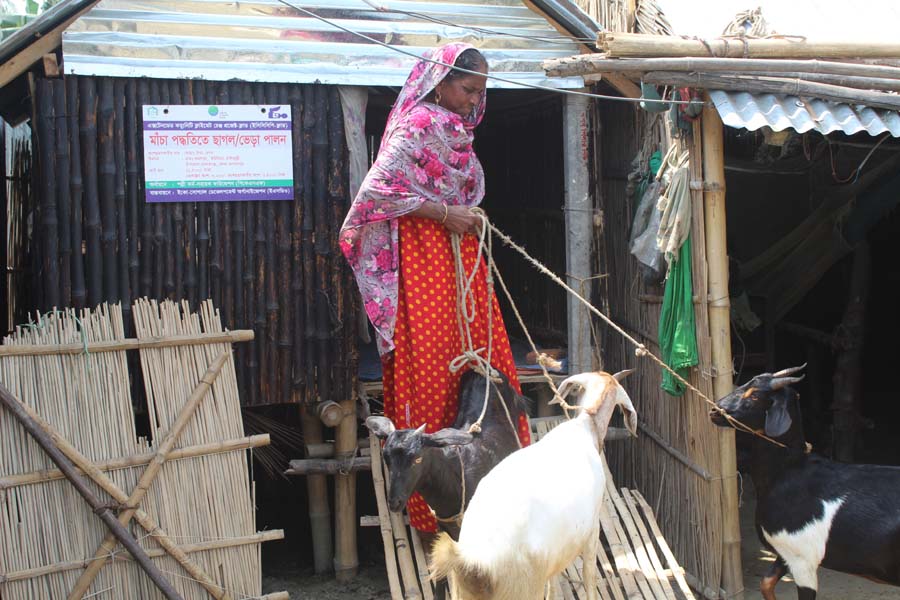
Rafiqul Islam
JAMALPUR, July 15, 2022 (BSS) – Usually climate change has been blamed for floods that put char dwellers in extreme distress and force them to watch in horror the havoc and reel under floods.
The hard-hit people living on chars of the Brahmaputra River have to embrace widespread damage to crops and property as lessons have been nestled in them in adapting to floods and changing climatic conditions.
Terrifying impact of the deluge keeps them alter all the time as the vulnerable people of char areas develop intricate network of man-made techniques to adapt to the natural disaster.
It is said civilizations have been wiped out by intensive flooding, so all concerned may do well to heed the warning.
As the disaster-prone people struggle to survive, the intransigence on taking effective adaptation steps may not be a good option because of the impact of floods falls on less well-off.
“We know flood will inundate our homesteads every year as we live in flood-prone areas of the Brahmaputra River. And we have no alternative to staying on the banana-plant-made rafts during floods,” said Abul Hossain, 70, of Char Shovagacha at Madarganj.
Recalling his long experiences in addressing floods, he said the char people must build floating platform with banana plants to keep their cattle on those during a flood.
“That’s why we plant banana orchards so that we can build rafts during flooding. Even we cut down premature banana trees to make rafts,” Abul Hossain said.
To maintain their livelihoods during floods, the char dwellers have started construction of goat-slatted houses on their raised homestead plinths, while women are now rearing goats and sheep in the slatted houses.
“In the past, we had to sell our goats with lower prices before starting a monsoon season as we had no way to keep our goats in lower homesteads during floods. So, we sold those,” said Eamily Begum of Char Shovagacha.
Like many other char dwellers, she constructed a goat-slatted house on her raised homestead. “Now we have no concern of keeping our goats during the flood. Now we will not sell our goats amid the flood situation,” she added.
Women also cultivate various vegetables and fruits on the raised homesteads to minimise the losses they incur due to floods.
“I have planted various vegetables and fruits on my homestead. I have already earned about Taka 1,400 by selling bottle gourd. I will be able to earn more money by selling papaya as the fruit has started reaping,” said Sima Begum of the same locality.
She added: “Forgetting the plights of flood, I find peace when I see pumper production of vegetables and fruits on my homestead.”
To cope with the floods, the char dwellers apply innovative adaptation practices to stay in the chars during floods, while they install the “hanging beds” with the roofs of their tin-sheet houses.
“Our homesteads are inundated with two to three feet high of floodwater during the monsoon. As they cannot avoid these circumstances, we install hanging beds to stay at our own houses,” said Nurul Mondal, another char resident.
He said the char dwellers install the “hanging beds” with the roofs of their tin-shed houses and hang onto those up and down, keeping pace with the floodwater level.
“And we live on these hanging beds during floods as we do not want to go to shelter centres leaving everything behind,” Nurul added.
The marginalised people generally depend on agriculture for their livelihood that is highly sensitive to climate change. But, the char farmers are now cultivating climate-tolerant crops like maize and wheat to cope with the flood disaster.
Farmer Mozam Mondal said peasants are now cultivating flood-tolerant maize on the arable land of chars as its productivity is very high and cost effective.
“I cultivated maize on one acre of char land this year and there was its bumper production,” he said.
“We like to sow maize on chars as we get the fair price of the cash crop. The price of maize is relatively high than other crops. I sold per maund (37.32 kg) of maize at Taka 1,300 this year,” said Mozammel Haque, a farmer of Char Dawlatpur at Saraisabari upazila.
Sima Begum said before a monsoon starts, the char people store puffed rice, flattened rice and other dry food items so that they can eat those during a flood.
Like other belongings, they also take precautionary measures to protect their land documents like deeds from floodwater.
“We wrap up our land documents with polythene papers and put those into a water-proof box so that floodwater cannot damage those,” said Rafiqul Islam, 60, of Char Dawlatpur.